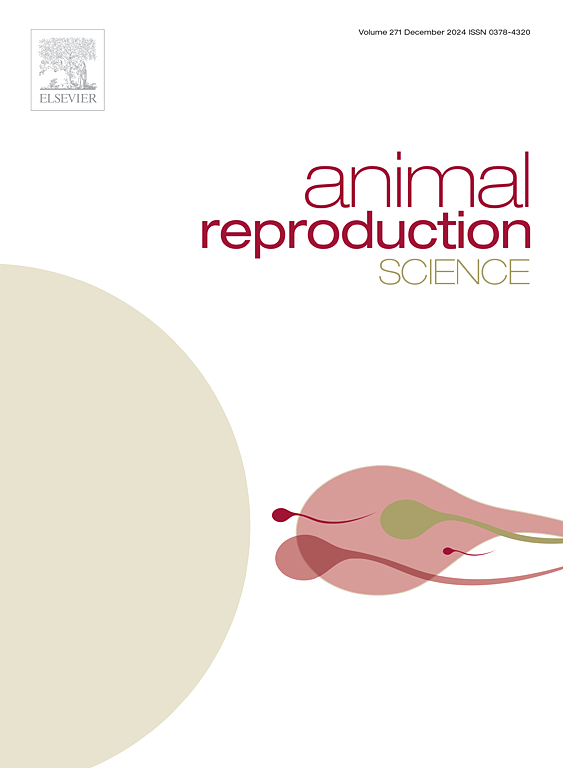Effect of 16h of rabbit sperm incubation on capacitation and heterologous in vitro fertilization
IF 2.2
2区 农林科学
Q1 AGRICULTURE, DAIRY & ANIMAL SCIENCE
引用次数: 0
Abstract
In vitro fertilization (IVF) in rabbits is an important biotechnology, but its success remains low due to inefficient sperm capacitation. This study examines relationships between motility parameters (MP), protein tyrosine phosphorylation (PTP) and acrosomal exocytosis (AE) between sperm recovered after direct swim-up (DSU), and after 16 h of in vitro incubation under capacitating conditions, and heterologous IVF capacity. Variables were assessed in fresh ejaculates (ES), and after 2 h of DSU, and 16 h (T16) of incubation. PTP were grouped into four patterns in the different sperm structures according to their time-dependent appearance and AE. Throughout incubation, MP remained stable whereas AE increased after DSU and 16 h of incubation. Mid-piece PTP patterns increased after DSU and persisted until 16 h in reacted (R) and non-reacted spermatozoa (NR). In R and NR, annulus-ring PTP levels were also significantly higher in T16 versus DSU or ES. Flagellum PTP levels rose significantly during incubation such that highest levels were recorded in T16. In R sperm, levels of PTP patterns associated with the equatorial zone in T16 were significantly higher compared to NR and to DSU and ES. Cleavage rates were significantly higher at T16 than DSU and these were similar to rates recorded for homologous IVF used as positive control. Our capacitation protocol and PTP patterns at 16 h rendered the sperm competent to fertilize an oocyte in vitro. This time point matches the physiological timing of fertilization in vivo. We also describe a new annulus ring PTP pattern for this species.
兔精子孵育16h对获能及异源体外受精的影响
兔体外受精(IVF)是一项重要的生物技术,但由于精子获能效率低,其成功率仍然很低。本研究探讨了直接游泳(DSU)和体外培养16 h后恢复精子的运动参数(MP)、蛋白酪氨酸磷酸化(PTP)和顶体胞吐(AE)与异源体外受精能力之间的关系。在新鲜射精(ES)、DSU 2 h和孵育16 h (T16)后评估变量。根据PTP随时间变化的外观和AE,将其在不同精子结构中分为四种模式。在整个孵育过程中,MP保持稳定,而AE在DSU和孵育16 h后增加。在反应精子(R)和非反应精子(NR)中,PTP模式在DSU后增加,并持续到16 h。在R和NR中,T16患者的环环PTP水平也明显高于DSU或ES。在孵育期间,鞭毛PTP水平显著上升,其中T16的水平最高。在R精子中,T16中与赤道带相关的PTP模式水平显著高于NR、DSU和ES。在T16时,卵裂率明显高于DSU,这与作为阳性对照的同源体外受精记录的卵裂率相似。我们的获能方案和16 h时的PTP模式使精子能够在体外与卵母细胞受精。这个时间点与体内受精的生理时间相吻合。我们还描述了一种新的环状PTP模式。
本文章由计算机程序翻译,如有差异,请以英文原文为准。
求助全文
约1分钟内获得全文
求助全文
来源期刊

Animal Reproduction Science
农林科学-奶制品与动物科学
CiteScore
4.50
自引率
9.10%
发文量
136
审稿时长
54 days
期刊介绍:
Animal Reproduction Science publishes results from studies relating to reproduction and fertility in animals. This includes both fundamental research and applied studies, including management practices that increase our understanding of the biology and manipulation of reproduction. Manuscripts should go into depth in the mechanisms involved in the research reported, rather than a give a mere description of findings. The focus is on animals that are useful to humans including food- and fibre-producing; companion/recreational; captive; and endangered species including zoo animals, but excluding laboratory animals unless the results of the study provide new information that impacts the basic understanding of the biology or manipulation of reproduction.
The journal''s scope includes the study of reproductive physiology and endocrinology, reproductive cycles, natural and artificial control of reproduction, preservation and use of gametes and embryos, pregnancy and parturition, infertility and sterility, diagnostic and therapeutic techniques.
The Editorial Board of Animal Reproduction Science has decided not to publish papers in which there is an exclusive examination of the in vitro development of oocytes and embryos; however, there will be consideration of papers that include in vitro studies where the source of the oocytes and/or development of the embryos beyond the blastocyst stage is part of the experimental design.
 求助内容:
求助内容: 应助结果提醒方式:
应助结果提醒方式:


